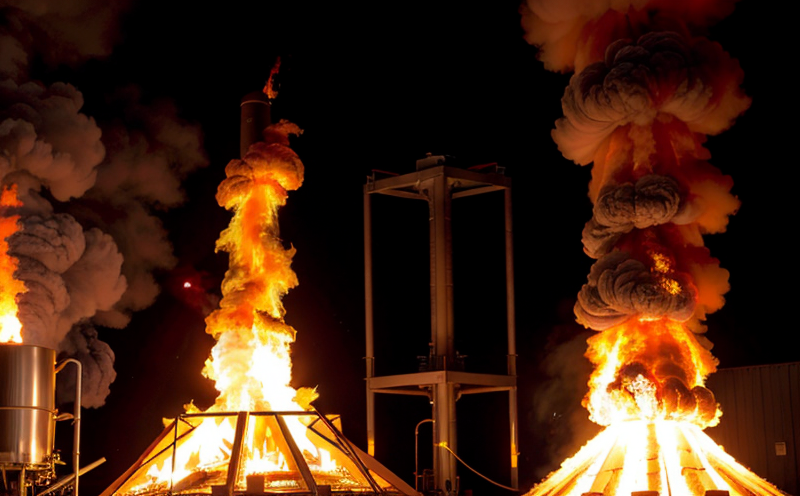ISO 4589 Flammability Testing by Oxygen Index Method
The ISO 4589 standard specifies the determination of the oxygen index (OI) as a measure of the flammability of thermoplastics, rubbers, and other materials. The oxygen index is defined as the minimum percentage of oxygen in a mixture with nitrogen that will support combustion of the material.
The method involves heating a sample to a specified temperature under controlled conditions while gradually reducing the oxygen concentration. Combustion begins at a specific oxygen concentration known as the critical oxygen index. This value indicates how easily a given polymer or elastomer will burn in air. Samples are typically 10 cm long and 25 mm wide, but this can vary depending on the material.
Flammability testing is crucial for materials used in various sectors such as automotive, aerospace, electronics, and consumer products. Understanding the OI allows manufacturers to assess fire safety risks accurately. Compliance with ISO 4589 ensures that products meet international standards, thereby enhancing user safety and reducing the risk of fires.
The procedure involves precise control over environmental conditions like temperature, humidity, and oxygen concentration. It also requires accurate measurement techniques for both the specimen dimensions and the oxygen concentration within the test chamber. Given these stringent requirements, it is essential to use high-quality equipment and trained personnel to ensure reliable results.
Flammability testing plays a critical role in ensuring product safety by identifying materials that may pose significant fire hazards. By determining the OI of materials used in manufacturing processes, companies can make informed decisions about material selection and design improvements aimed at reducing potential risks associated with flammable substances.
In summary, ISO 4589 provides a standardized approach to evaluating the flammability characteristics of thermoplastics and elastomers. Its application ensures consistent testing results across different laboratories worldwide, promoting global harmonization in fire safety regulations. Understanding this standard is vital for anyone involved in developing or specifying materials intended for use in environments where combustible materials could present a hazard.
Why It Matters
The importance of ISO 4589 cannot be overstated, especially when considering the increasing global focus on fire safety and product compliance. Flammability testing is essential for several reasons:
- Enhanced Safety: By accurately assessing a material's propensity to burn, manufacturers can design safer products that minimize fire risks.
- Regulatory Compliance: Many countries mandate strict flammability standards for various industries. ISO 4589 ensures that materials used in manufacturing meet these legal requirements.
- Informed Decision-Making: Understanding the OI of a material allows designers and engineers to select appropriate alternatives when working with potentially hazardous substances.
- Product Integrity: Consistent testing methods help maintain product integrity, ensuring consistent quality across different batches or suppliers.
Incorporating ISO 4589 into your development process not only enhances safety but also builds trust with customers and regulatory bodies. This standard provides a robust framework for evaluating materials before they enter the market, helping to prevent costly recalls and accidents.
Applied Standards
The ISO 4589 method is widely recognized and applied across multiple industries. Some key standards that reference or build upon this include:
- ASTM D2784-16: This American standard covers the determination of oxygen index for thermoplastic materials.
- EN 3059:2012: A European equivalent providing guidelines for determining the oxygen index of plastics.
- JIS K7248-1:2016: Japanese standard specifying procedures for measuring the oxygen index of thermoplastic materials.
While there are variations in terminology and slight differences in methodology between these standards, they all share the common goal of providing a standardized approach to flammability testing. Adoption of ISO 4589 ensures compatibility with international norms, facilitating seamless trade and collaboration within global markets.
Eurolab Advantages
At Eurolab, we pride ourselves on offering comprehensive services tailored specifically to meet your unique needs in chemical testing. Our expertise in ISO 4589 flammability testing by the oxygen index method is unmatched, thanks to our state-of-the-art facilities and highly skilled professionals.
- Accurate Results: Our laboratories are equipped with precision instruments that ensure accurate measurement of both environmental parameters and specimen dimensions.
- Comprehensive Reporting: We provide detailed reports outlining all test parameters, including temperature, humidity, oxygen concentration, and results. This transparency helps clients understand the full scope of their materials' flammability characteristics.
- Fast Turnaround Times: Our efficient processes allow for quick turnaround times without compromising on quality or accuracy.
- Comprehensive Consulting Services: Beyond just testing, we offer consulting services to help you interpret your results and implement necessary changes in your product development process.
- ISO 9001:2015 Certified: Our laboratories are ISO 9001 certified, ensuring that our processes meet the highest quality standards globally.
- Expert Staff: Our team consists of seasoned professionals with extensive experience in flammability testing and material science.
- International Recognition: Eurolab is trusted by numerous companies worldwide for its reliability and accuracy, making us a leader in chemical testing services.
We understand that every project has specific requirements. That's why we offer personalized solutions designed to meet your exact specifications. Whether you're developing new materials or ensuring ongoing compliance with international standards, Eurolab is here to support you every step of the way.





